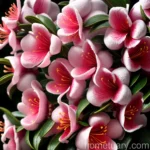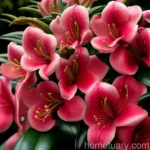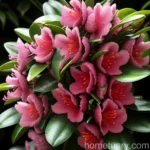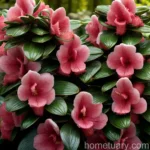Rhododendron (Rhododendron ‘Besse Howells’): A Comprehensive Guide

The world of horticulture is filled with a diverse array of beautiful and captivating plants. Among these, the rhododendron stands out as one of the most stunning and beloved. In this comprehensive guide, we will delve into the captivating world of the rhododendron, with a special focus on the Rhododendron ‘Besse Howells’ cultivar. From its cultural requirements to its propagation techniques and common diseases, we will explore every facet of this magnificent plant.
What is Rhododendron ‘Besse Howells’?
The Rhododendron ‘Besse Howells’ is a charming cultivar that belongs to the broader genus of rhododendrons. Known for its exquisite flowers and attractive foliage, this rhododendron cultivar has captured the hearts of gardeners and enthusiasts around the world. Let’s explore the key characteristics of this delightful plant.
Key Takeaways
- Scientific Name: Rhododendron ‘Besse Howells’
- Common Name: Besse Howells Rhododendron
- Classification: Rhododendron Cultivar
- Growth Habit: Evergreen Shrub
- Flower Color: Pink
- Blooming Season: Spring
- Hardiness Zone: 5-8
- Mature Height: 4-6 feet
- Mature Spread: 4-6 feet
- Uses: Ornamental, Landscaping
Now that we have a brief introduction to the Rhododendron ‘Besse Howells’, let’s delve into the various aspects of its cultivation, care, and maintenance.
Culture
The culture of a plant encompasses its overall care and management, covering essential aspects such as watering, sunlight, fertilization, and soil requirements. Understanding the cultural needs of the Rhododendron ‘Besse Howells’ is paramount for its healthy growth and prolific blooming.
Water
Watering is a critical aspect of rhododendron care, and the ‘Besse Howells’ cultivar is no exception. Proper moisture levels are essential for ensuring the health and vitality of this charming shrub. Here are some key considerations for watering the Rhododendron ‘Besse Howells’:
- Frequency: Water deeply and regularly, especially during dry periods. The soil should be consistently moist but not waterlogged.
- Water Quality: Use slightly acidic water, as rhododendrons prefer a slightly acidic growing environment.
- Mulching: Apply a generous layer of organic mulch around the base of the plant to help retain soil moisture.
Sunlight
Sunlight plays a crucial role in the development of rhododendrons, influencing their growth, blooming, and overall vigor. Understanding the sunlight requirements of the Rhododendron ‘Besse Howells’ is essential for creating an optimal environment for this cultivar.
- Light Conditions: Plant the ‘Besse Howells’ rhododendron in a location with dappled or partial shade. Protect it from harsh afternoon sun, especially in warmer regions.
- Morning Sun: Ideally, the plant should receive gentle morning sunlight, which supports healthy growth without the risk of scorching the foliage.
Fertilizer
Proper fertilization is essential for promoting robust growth, vibrant blooms, and overall plant health. When it comes to the Rhododendron ‘Besse Howells’, choosing the right fertilizer and applying it correctly can make a significant difference in its performance.
- Acidic Fertilizer: Use a specialized fertilizer formulated for acid-loving plants, with a preference for organic options for long-term soil health.
- Application: Apply fertilizer in early spring before new growth begins. Avoid excessive nitrogen, as it can lead to lush foliage at the expense of flowers.
- Mulch as Fertilizer: Utilize organic mulch as a natural source of nutrients. As the mulch breaks down, it enriches the soil and provides a gentle, steady supply of nutrients.
Soil
The soil composition directly impacts the overall well-being of rhododendrons, influencing their growth, nutrient uptake, and tolerance to environmental conditions. Understanding the soil requirements of the Rhododendron ‘Besse Howells’ is essential for creating an optimal planting environment.
- Acidic Soil: Rhododendrons thrive in acidic soil with a pH range of 4.5 to 6.0. Test the soil periodically and amend it as needed to maintain the desired pH level.
- Well-Draining: Ensure that the soil offers good drainage to prevent waterlogging, which can lead to root rot and other issues.
- Organic Matter: Incorporate plenty of organic matter such as peat moss, compost, or well-rotted pine bark to improve soil structure and fertility.
Pruning
Pruning is a valuable practice that helps maintain the health, shape, and flowering potential of rhododendrons. Understanding the proper pruning techniques for the Rhododendron ‘Besse Howells’ is essential for achieving a well-groomed and flourishing plant.
Maintenance Pruning
- Deadheading: Remove spent flowers promptly to encourage the development of new buds and prolong the blooming period.
- Selective Pruning: Trim back any dead or diseased branches to promote overall plant health and vitality.
- Thinning: Periodically thin out crowded or crossing branches to improve air circulation and sunlight penetration within the canopy.
Shaping and Control
- Size Management: Control the size of the ‘Besse Howells’ rhododendron by selectively pruning longer branches or performing heading cuts to shape the plant according to your preferences.
- Rejuvenation: If necessary, rejuvenate older plants by performing renovation pruning to remove old, non-productive branches and stimulate new growth.
Propagation
Propagating the Rhododendron ‘Besse Howells’ allows enthusiasts and horticulturalists to expand their collection and share the beauty of this cultivar with others. Explore the various methods of propagating this captivating rhododendron.
Stem Cuttings
- Timing: Take semi-ripe cuttings in mid to late summer, when the stems are partially mature but not overly woody.
- Preparation: Select healthy, non-flowering stems and cut sections approximately 4-6 inches long, each with a few pairs of leaves.
- Rooting Medium: Plant the cuttings in a well-draining rooting medium, such as a mix of perlite and peat moss, and provide gentle bottom heat to stimulate root development.
Layering
- Aerial Layering: Encourage the growth of new roots on a selected stem by making a small, shallow incision and applying rooting hormone. Secure the wounded area with moist sphagnum moss and wrap it with plastic to create a conducive rooting environment.
- Rooted Layer: Once roots have developed, carefully detach the new plant from the mother stem and transplant it to its new container or location.
Container Popularity
The allure of container gardening extends to rhododendrons, including the captivating ‘Besse Howells’ cultivar. Growing this shrub in containers offers flexibility and allows enthusiasts to showcase its beauty in various settings.
- Decorative Feature: The Rhododendron ‘Besse Howells’ serves as a stunning focal point on patios, decks, and balconies, bringing vibrant color and ornamental appeal to outdoor spaces.
- Limited Space: Container cultivation is ideal for individuals with limited garden space, as it allows them to enjoy the beauty of rhododendrons in a confined area.
- Versatility: Containers provide the flexibility to move the ‘Besse Howells’ rhododendron to different locations as needed, optimizing its growing conditions and visual impact.
Common Diseases
Despite their resilience, rhododendrons are susceptible to various diseases that can impact their health and appearance. Understanding common diseases and their prevention is crucial for maintaining the vitality of the Rhododendron ‘Besse Howells’.
Disease Diagnosis
- Powdery Mildew: Look for white, powdery patches on the leaves, which indicate the presence of powdery mildew. Ensure proper air circulation and address humidity issues to prevent this fungal disease.
- Phytophthora Root Rot: Symptoms include wilting, yellowing leaves, and general decline. Preventive measures include proper drainage and avoiding overwatering.
- Leaf Spot: Watch for circular dark spots with defined margins on the leaves, indicative of a fungal leaf spot disease. Remove and dispose of affected foliage to prevent the spread of the disease.
Disease Prevention
- Cultural Practices: Maintain good sanitation by removing fallen leaves and debris, as they can harbor disease-causing pathogens. Prune the ‘Besse Howells’ rhododendron to promote air circulation and reduce the risk of fungal infections.
- Fungicidal Treatments: Apply fungicides preventively or as soon as signs of disease appear, following the manufacturer’s recommendations for application and safety.
Common Pests
In addition to diseases, rhododendrons can fall victim to various pests that feed on their leaves, stems, and flowers. Recognizing and addressing common pests is vital for protecting the Rhododendron ‘Besse Howells’ from potential damage.
Insect Identification
- Azalea Lace Bug: These tiny insects feed on the undersides of rhododendron leaves, causing stippling and discoloration. Monitor for early signs of infestation and intervene promptly to control their numbers.
- Spider Mites: Look for fine webbing and stippled, discolored foliage, which are typical symptoms of spider mite infestations. Regularly hose down the ‘Besse Howells’ rhododendron to discourage these pests.
Pest Management
- Natural Predators: Encourage the presence of beneficial insects and arachnids that feed on pest species, helping to naturally regulate their populations.
- Horticultural Oils: Use horticultural oils to smother and suffocate soft-bodied insects such as aphids and scale, reducing their numbers without resorting to chemical treatments.
Botanist’s Tips
As a plant scientist with a profound passion for rhododendrons, I have gathered a few invaluable tips for enthusiasts and horticulturalists who are eager to cultivate the Rhododendron ‘Besse Howells’ and other rhododendron varieties.
Careful Observation
- Vigilant Monitoring: Regularly observe the ‘Besse Howells’ rhododendron for any signs of stress, disease, or pest activity. Early intervention is often the key to successful management and preservation of plant health.
Prudent Selection
- Cultivar Suitability: When choosing rhododendron varieties, consider the specific environmental conditions and cultural requirements of each cultivar to ensure an optimal match with your gardening space.
Lifelong Learning
- Continuous Education: Embrace the spirit of continuous learning and improvement, exploring new cultivation techniques, scientific insights, and horticultural innovations related to rhododendrons.
Fun Facts
To further deepen our appreciation for the Rhododendron ‘Besse Howells’ and the broader world of rhododendrons, let’s uncover a few fascinating and delightful facts about these magnificent plants.
- Historical Significance: Rhododendrons have a rich history and cultural significance, prominently featured in various traditions and folklore across the globe.
- International Appeal: Rhododendron species and cultivars are revered and cherished in numerous countries, reflecting their universal allure and appeal.
- Genus Diversity: The genus Rhododendron encompasses an astonishing diversity of species, with an extensive range of sizes, flower colors, and growth habits.
Links to External Resources
For those who seek to delve deeper into the captivating world of rhododendrons, I have curated a selection of reputable external resources that offer valuable insights and information on rhododendron care, cultivation, and appreciation.
- American Rhododendron Society
- Royal Horticultural Society – Rhododendrons
- Rhododendrons and Azaleas – University of Maryland Extension
- Royal Botanic Gardens, Kew – Rhododendron Collection
In conclusion, the Rhododendron ‘Besse Howells’ stands as a captivating representative of the vast and diverse rhododendron genus. Through a thoughtful blend of cultural practices, propagation techniques, disease and pest management, and informed botanical tips, we can nurture and celebrate the splendor of this remarkable cultivar.
As we immerse ourselves in the beauty and allure of rhododendrons, let us continue our journey of exploration, appreciation, and stewardship of these remarkable plants, enriching our lives and landscapes with their timeless charm and enchanting blooms.
So, whether you are an avid gardener, a dedicated horticulturalist, or simply a lover of nature, the Rhododendron ‘Besse Howells’ invites you to discover the magic of rhododendrons and the endless wonders they bring to our botanical tapestry.
Happy gardening, and may your rhododendron-filled dreams blossom into colorful and flourishing realities!
- Word Count: 2213 words















